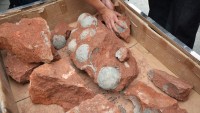Fossils of a Platypus Dinosaur, the Milder Cousin of the T-rex Was Discovered In Chile
| Marco Foronda | | Apr 28, 2015 08:59 PM EDT |
(Photo : Gabriel Lio) Depiction of the Chilesaurus diegosuarezia or platypus dinosaur whose fossils were discovered in Chile.
Fossils of a platypus-like dinosaur were recently discovered in Chile by a team of researchers, according to a paper published on Monday in Nature.
The bill of the "Chilesaurus diegosuarezia" was distinctly similar to a platypus', thus palaeontologists refer to it as the platypus dinosaur. It roamed in Chile 145 million years ago near the end of the Jurassic period.
Like Us on Facebook
The Chilesaurus was named after Diego Suarez, the 7 year-old Geologist's son, who first found the fossils at the Toqui Formation in southern Patagonia.
It had a long neck and a skull proportionally smaller than its body. The size of the feet measured similarly to that of other dinosaurs with long necks as well, the paper notes.
In addition, it was reminiscent of the Tyrannosaurus rex or T-rex for having two fingers on each hand. Only, it was a plant-eater and not a predator as its teeth were made for chewing plants.
The fossils unearthed were at the different stages of development, according to the paper.
Most of them were the size of a turkey, but researchers determined the probable length to be three meters, judging from the bigger bones present in the sample. They reasoned that the big ones had actually been longer.
But what really excites the researchers was the presence of a unique mixture of anatomy in the Chilesaurus fossils, a situation experts call "mosaic convergent evolution."
Here, an organism develops characteristics present in other unrelated organisms. It's like borrowing traits from species that mirrors the same lifestyle, University of Birmingham's Dr. Martin Ezcurra said.
"Chilesaurus provides a good example of how evolution works in deep time and it is one of the most interesting cases of convergent evolution documented in the history of life," Dr. Ezcurra, also an author of the paper, said.
Chilesaurus was discovered at a site in Chile's Upper Jurassic, named so for its record of yielding fossils of the period.
TagsFossil, evolution, Chile, Patagonia, Jurassic period
©2015 Chinatopix All rights reserved. Do not reproduce without permission
EDITOR'S PICKS
-

Did the Trump administration just announce plans for a trade war with ‘hostile’ China and Russia?
-

US Senate passes Taiwan travel bill slammed by China
-

As Yan Sihong’s family grieves, here are other Chinese students who went missing abroad. Some have never been found
-

Beijing blasts Western critics who ‘smear China’ with the term sharp power
-

China Envoy Seeks to Defuse Tensions With U.S. as a Trade War Brews
-

Singapore's Deputy PM Provides Bitcoin Vote of Confidence Amid China's Blanket Bans
-

China warns investors over risks in overseas virtual currency trading
-

Chinese government most trustworthy: survey
-

Kashima Antlers On Course For Back-To-Back Titles
MOST POPULAR
LATEST NEWS
Zhou Yongkang: China's Former Security Chief Sentenced to Life in Prison

China's former Chief of the Ministry of Public Security, Zhou Yongkang, has been given a life sentence after he was found guilty of abusing his office, bribery and deliberately ... Full Article
TRENDING STORY

China Pork Prices Expected to Stabilize As The Supplies Recover

Elephone P9000 Smartphone is now on Sale on Amazon India

There's a Big Chance Cliffhangers Won't Still Be Resolved When Grey's Anatomy Season 13 Returns

Supreme Court Ruled on Samsung vs Apple Dispute for Patent Infringement

Microsoft Surface Pro 5 Rumors and Release Date: What is the Latest?













